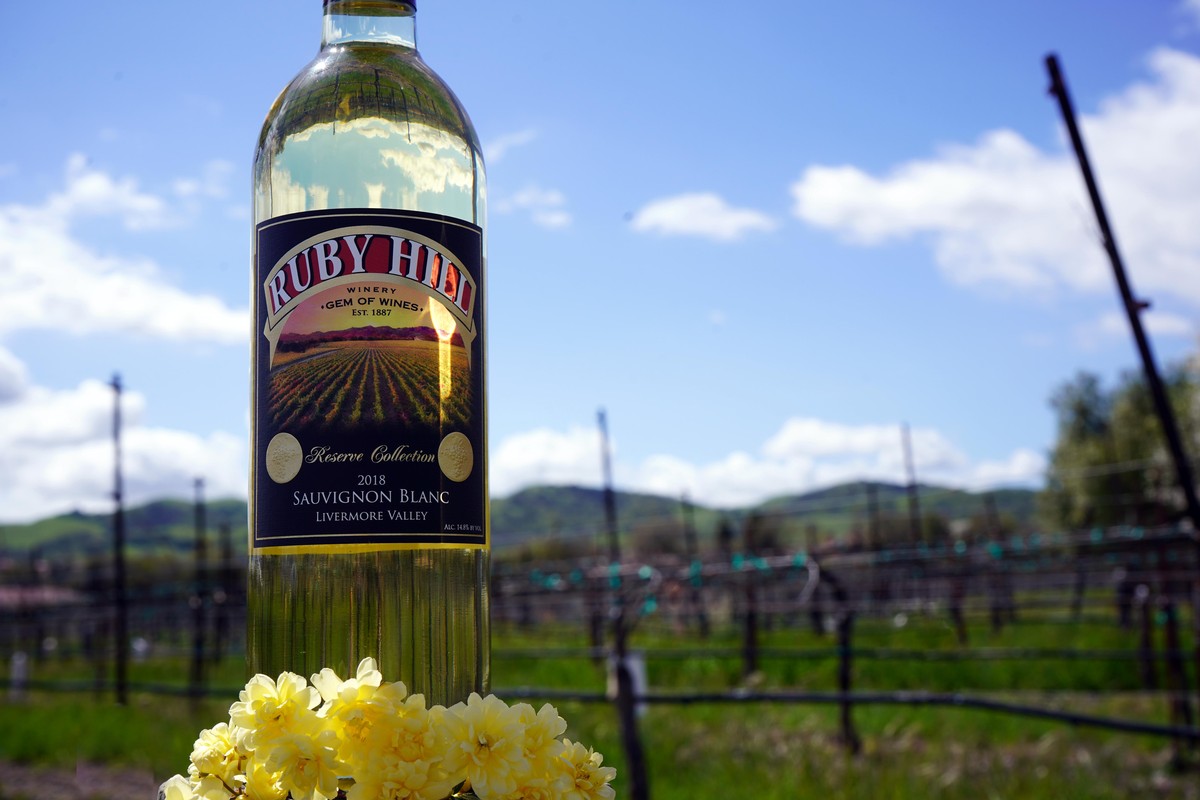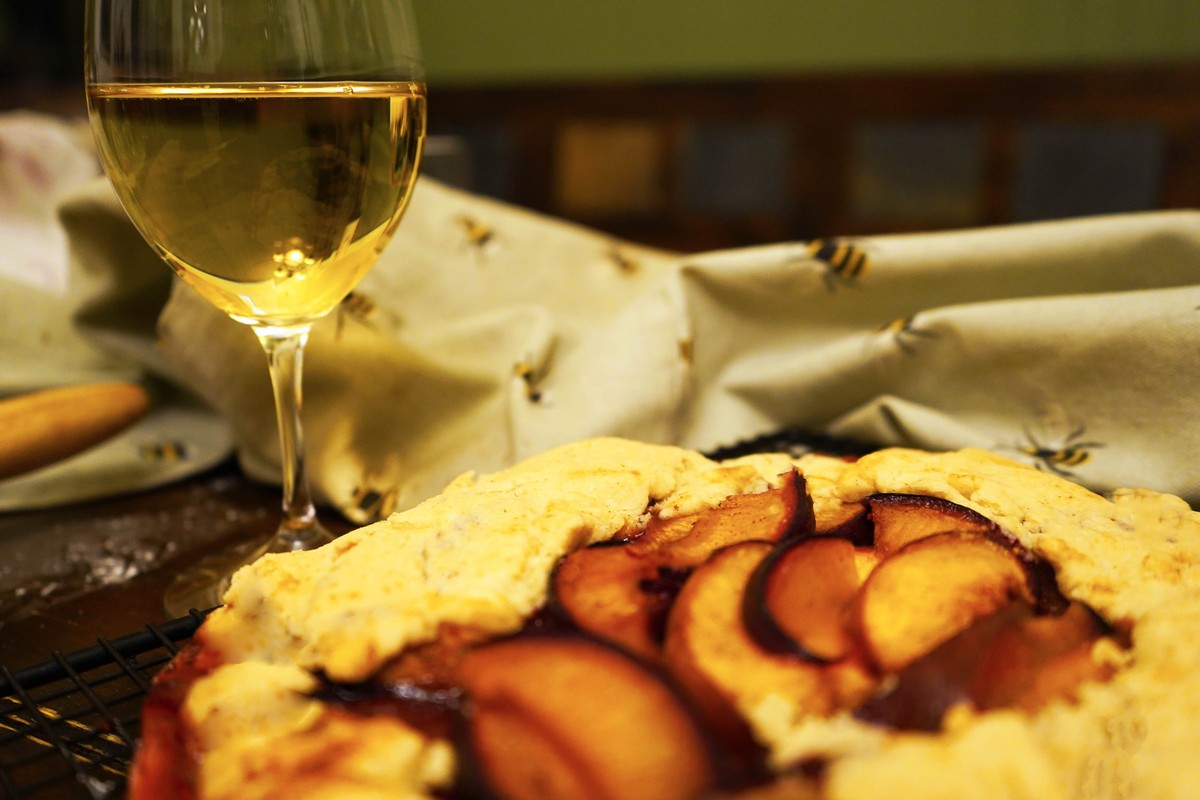Golden Wine from a Wild Vine
Here at Ruby Hill Winery, Sauvignon Blanc is a family favorite. Its crisp, floral, fruity notes are perfect for celebrating the arrival of spring, but we have no trouble enjoying it all year long. We think that Sauvignon Blanc is a fascinating varietal, so we've rounded up some facts you might not know about this delectable white!
Sauvignon Blanc vines grow with determination
Hailing from the Bordeaux region of France, this vine earned the title "sauvignon" from the French word sauvage which can be translated as "wild, untamed, or feral." This name came from the vigor with which the vines grow, requiring careful maintenance to keep them in line. Literally translated, Sauvignon Blanc is "the wild white." Here at Ruby Hill, it goes by the nickname "Sauv Blanc" or sometimes even "Sauvvy-B."
Sauvignon Blanc is the mother of a classic
According to genetic analysis performed by researchers at UC Davis, Sauvignon Blanc vines played an important role in the creation of the most popular varietal in the world. Their findings showed that sometime in the 1600s, a Sauvignon Blanc cross-pollinated with a Cabernet Franc vine, producing the very first vine of Cabernet Sauvignon. It's likely this cross-breeding was by chance, but it was an accident of the best kind in our book!
Sauvingon Blanc is different around the world
This beloved wild white is grown all around the world, including France, Italy, Spain, Bulgaria, Romania, New Zealand, USA, Canada, Chile, South Africa, and Australia (to name a few). With over 275,000 acres planted worldwide, it is the 8th-most grown wine grape in the world. Because of the delicate complexities of Sauv Blanc, there are region-specific characteristics that vary from country to country. When grown in colder areas, the wine will usually have more flavors of lime or green apple, while the wine of warmer regions may have notes of ripe passionfruit and peaches.
Tasting Sauvignon Blanc can expand your vocabulary
Well, sort of! Sauvingon Blanc was the first wine to be regularly described in terms of a unique chemical compound. Some of the flavors that are completely unique to Sauvignon Blanc are owed to substances called methoxypyrazines. This component of the wine is what causes the hallmark notes of Sauvignon Blanc, often described as herbaceous, grassy, or as having notes of gooseberry or even asparagus.
Sauvignon Blanc is a polished pairing
The reliably crisp nature of Sauvignon Blanc is owed to the combination of its higher acidity and fairly low sugar content. Sauv Blanc is known as an enjoyable pairing for sushi which is notoriously difficult for wine pairings. It is hard to go wrong when pairing Sauvignon Blanc with soft ripened cheeses or white meats, especially if served in a creamy sauce. Green herbs like mint or basil form a pleasant flavor bridge between the dish and the herbaceous notes of the wine. If you're looking for a pairing for Ruby Hill Winery's Sauvignon Blanc, we think this wine shines when paired with Artichoke Crab Paella.
Did any of these surprise you? Tag us @rubyhillwinery
We think it's time to go pour a glass. Our Reserve Sauvingon Blanc is on sale for only a couple more days! Enjoy our fusion of old-world style and crisp tropical refreshment for only $20.
Spring in Technicolor
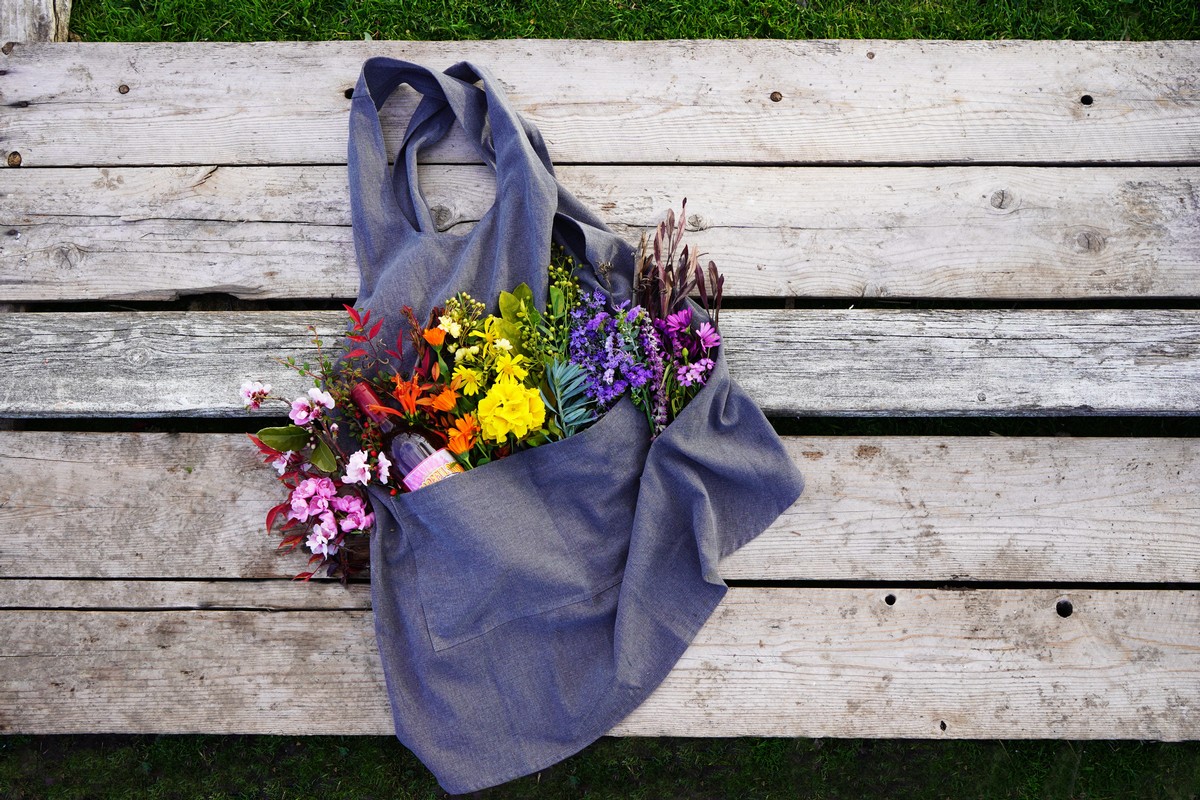
With recent rains and the rapid arrival of spring in Northern California, our rolling hills and scenic valleys will soon be awash in color. We’re in love with the rainbow of wildflowers and native plants that spray color of every kind across the landscape. It’s the perfect time to find a walking trail and go luxuriate in the scenery of one of the most naturally beautiful places in the world—right here. March marks the beginning of Northern California's wildflower season, which continues as late as mid-July. If you keep an eye out, you’ll find flowers in every color of the rainbow in no time. Below, we’ve listed some of our favorite blooms common to this region.
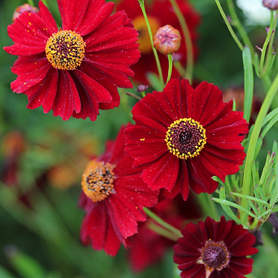
Red - Mahogany Calliopsis
This scarlet bloom is just one variety of Calliopsis, a hardy plant that grows well even in dry or rocky soils. Also known by the common name of "Tickseed," the flowers also come in a rich golden-yellow hue, sometimes boasting a burgundy center. Historically, the flowers of the Calliopsis have been used for both red and yellow dyes. These flowers are at home in wild meadows as well as gardens, where they often attract the attention of butterflies.
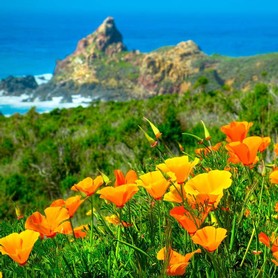 Orange - California Poppy
Orange - California Poppy
The iconically vibrant petals of the California Poppy unfurl themselves on warm, sunny days and fold back up in the evening. According to some records, early Spanish explorers nicknamed California "the land of fire" because of the vivid meadows along the coastline. Declared the state flower in 1903, the California poppy grows prolifically throughout the state and into other regions. Other names for this flower include the "Flame Flower" and "Copa de Oro" which means "cup of gold."
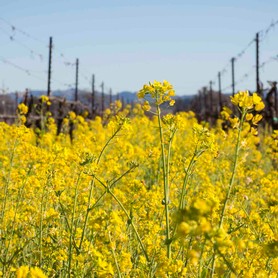 Yellow - Wild Mustard
Yellow - Wild Mustard
This cheerful yellow blossom and its common cousin Black Mustard are easily spotted throughout Northern California, content to grow nearly anywhere from vineyards to the side of the highway. Yellow Mustard is native to Eurasia, rather than California, but it thrives in this climate. It is believed that Franciscan Padres introduced the plant when they scattered mustard seeds along the 600-mile Camino Real so it could be easily found by travellers.
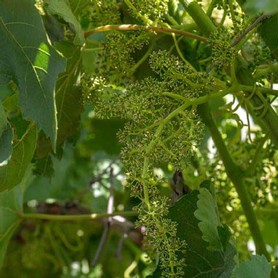 Green - Grape Vines
Green - Grape Vines
After spending the winter months dormant and bare, the green leaves and shoots that emerge in the vineyard with the warmer weather are a welcome sight. When the conditions are right and the growth is at its peak, some grape vines can grow more than an inch in length in a single day. The blossoms themselves grow in cluster formations and the blooms last only 8-10 days. This bloom occurs around mid-May, depending on the varietal and climate of the region.
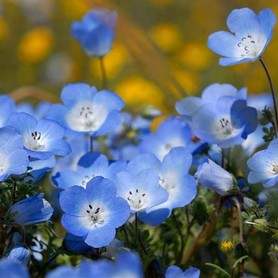 Blue - Baby's-Blue-Eyes
Blue - Baby's-Blue-Eyes
These darling herbal blossoms are among the most common of California's native wildflowers. Often seen growing in gorgeous contrast among poppies, these little flowers earn their name from their white centers which emulate an "eye." These charming flowers are surprisingly hardy, having been introduced and cultivated in less favorable climates including Alaska and England. Baby's-Blue-Eyes has also been recognized by ecologists as a valuable attractor and supporter of native bee populations.
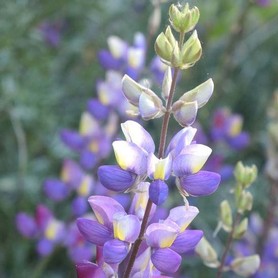 Purple - Silver Lupine
Purple - Silver Lupine
This highly adaptable wildflower can grow gorgeous spears of purple petals up to a foot long. The Silver Lupine's flowers can range in hue from violet to pale blue and the silvery leaves give it a soft, ethereal appearance. Bitter compounds in the plant also make it a good option for gardeners looking for deer-resistant foliage. Additionally, the endangered Mission Blue Butterfly requires Lupine for a portion of its life cycle, so it's a great plant for any fan of conservation and beautiful wildflowers.
If you're interested in going out to go wildflower-watching,
click here to find information on when and where to find the best California blooms!
Luscious Stone Fruit Galette
All month long, we're celebrating our refreshing and expressive Reserve Sauvignon Blanc. Delicious in cold and warm weather alike, this wine is pleasant from nose to palate. In addition to the taste, we love the pairing opportunities, but it's hard to decide between them all! Mouthwatering options include a fresh and comforting basil risotto, a scrumptious grilled vegetable pasta, or a flavorful artichoke crab paella. Lately, we've been craving something sweet, so we're celebrating the fruity, tropical nose, and the prominent notes of stone fruit in this wine by baking up a fresh fruit galette.
If you aren't familiar with galette, don't worry! It's a simple, classic dessert, similar to a pie but even easier to make. It comes together very quickly, especially if you have a pre-made pie crust, and due to its rustic look, every galette is a beautiful galette. Best of all, you can tweak the ingredients to your taste, and in our case, to pair perfectly with the Wine of the Month. Grab your favorite apron and a wine glass, it's time to make something delicious!
Stone Fruit Galette
Ingredients for pastry:
- 1 1/2 cups all-purpose flour
- 1/4 cup finely ground white cornmeal
- 1 tablespoon granulated sugar
- 1/4 teaspoon salt
- 1 stick (8 tablespoons) cold unsalted butter, cubed
- 1/4 cup ice water, divided
Ingredients for filling:
- 1 to 1.5 pounds of stone fruit (we used nectarines and black plums)
- 1/4 cup turbinado sugar
- 1 tablespoon all-purpose flour
- 1 teaspoon ground cinnamon
- 1/2 teaspoon freshly grated nutmeg
- 1/2 teaspoon ground cardamom
- 1/4 teaspoon salt
- 1 tablespoon apricot jam
- 1 tablespoon unsalted butter, cubed
- 1 large egg, beaten
Directions
- For the pastry, we recommend using a food processor to combine the dough.
- Pulse a few times to combine the dry ingredients in the work bowl of your food processor.
- Add the cubed cold butter and pulse about 7-10 times to combine. Don't worry too much about combining it finely, lumps of butter are perfect in a galette crust.
- Slowly add in just enough water to make the dough hold together when pressed. Start with 2 tablespoons and increase if needed.
- Wrap the dough in plastic wrap and let it chill in the refrigerator for at least 30 minutes.
- Preheat the oven to 400°F.
- To begin the fruit filling, cut your fruits in half, remove the pits, and cut the fruit into 1/4 inch-thick slices. The shorter cooking time for galette makes thinner slices necessary for the fruit to cook.
- Toss the fruit with the sugar, flour, spices, and salt.
- Roll out the dough into a rough circle (it doesn't have to be perfect, just call it "rustic"), about 12 inches across.
- Place the disk onto a parchment-lined baking sheet.
- Spread the apricot jam in a circle across the pastry, leaving a 2-inch border.
- Carefully pile the fruit filling atop the jam, maintaining the border.
- Fold the edges of the crust over the fruit all the way around, overlapping the dough and pleating as you go.
- Once assembled, distribute the cubes of butter across the top of the fruit. Brush the beaten egg across the top of the crust and sprinkle with sparkling sugar.
- Bake in the middle rack of the oven for 30-35 minutes. The fruit should be cooked and bubbly and the crust golden-brown.
- Transfer the galette, parchment and all, to a wire rack and let it cool completely before slicing.
Recipe inspiration from the Kitchn
By adjusting the amount of sugar and choice of seasonings, galettes can use nearly any fruit or even be enjoyed as a savory dish with vegetables and cheese. The filling is an ideal place to infuse other flavors; a little lemon zest, warm spices, and even fresh herbs are thoughtful additions. When it comes to making a delicious galette, you can explore your favorite flavor combinations and experiment as much as you'd like. If you'd prefer a savory galette recipe to pair with our Sauvigon Blanc, we recommend this Roasted Vegetable Galette from Diala's Kitchen!
If we've inspired you, please let us know on social media @rubyhillwines
Smiles Too Wide to Hide

Amid the twists, turns, and surprises of the last year, it seems some days that there's a deficit of smiles in our daily interactions. Here at Ruby Hill, we always hope to brighten up your day. We've always said that smiles are the best accessory. Since we take the health and safety of our associates and visitors seriously, we've covered our faces—but we're still grinning. This week, we're bringing together science and experience to reflect on some reasons to smile, even behind our masks. While we're at it, we've caught some of our staff"s lovely smiles on camera.
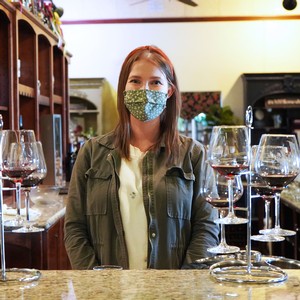 Smiles can come in all forms, shapes and sizes, and for every reason. We visited the tasting room this week to ask the staff what had made them smile lately. Riley, our club manager, mentioned her dog, a spirited boxer who's always ready to take attention and give a smile. Another staff member, Stacy, is an elementary school teacher and spoke of how her students make her smile with their enthusiasm for returning to school. Olivia, one of our tasting room helpers, mentioned that her friends make her smile with their humor and sincere support. The list could go on. Of course, few things make us smile quite like opening our favorite wines.
Smiles can come in all forms, shapes and sizes, and for every reason. We visited the tasting room this week to ask the staff what had made them smile lately. Riley, our club manager, mentioned her dog, a spirited boxer who's always ready to take attention and give a smile. Another staff member, Stacy, is an elementary school teacher and spoke of how her students make her smile with their enthusiasm for returning to school. Olivia, one of our tasting room helpers, mentioned that her friends make her smile with their humor and sincere support. The list could go on. Of course, few things make us smile quite like opening our favorite wines.

As it turns out, even if it feels hidden, masks can't stop authentic smiles. Just like you can hear someone's smile when talking on the phone, smiles can be heard behind the mask. If you ever feel disconnected from others, smile as you speak and listen for their smile. Smiling as you interact with someone can actually change your mood and perception, as well as theirs. This is great news because even small moments of social contact help improve physical and mental health, including boosting immunity and reducing stress.
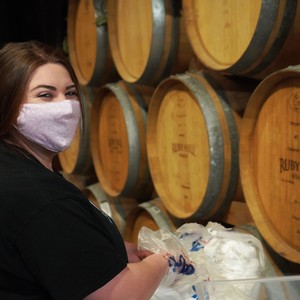
One element of the smile even stronger than the sound is the way that smiles are seen in your eyes. Humans are incredibly adept at reading the eyes of others. In fact, the eyes are one of few places where true emotions can't effectively be hidden. You may not realize that the little crinkle at the corners of your eyes is what a person needs today, and what you need too. Masks can filter out some fake smiles, but can’t hide the real ones that creep up and shine through the eyes.
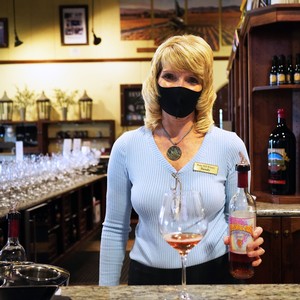
Smiles are like a little boost to both brain and body. Psychological research has found that social body language that seems to have little to do with smiling, like waving, is actually enhanced by the presence of a smile (even if the smile is obscured by a mask). Not only does your smile power-up your wave, it powers you up. Studies have found that engagement with others simply makes us feel better, whether we're introverted or extroverted.

Thanks to a social brain quirk known as "mirror neurons," our smiles can trigger positive emotions in others and in ourselves—even if the smile was fake at first! If you want to smile, do it. We promise it’s not wasted.
We hope we can put a smile on your face if we haven't already. Feel free to visit us any day of the week! Wave hello, tell your favorite joke, or take a moment of gratitude to smile about someone you love. We'd love it if you shared your smiles with us, @rubyhillwines.
Enjoy complimentary ground shipping when you order 6 or more bottles.
Sign Up For Our Newsletter
Keep up to date on the latest wine releases, events, and promotions.
